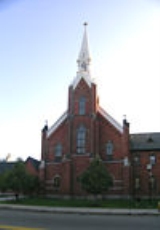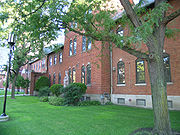
St. Bonaventure Monastery
Encyclopedia
The St. Bonaventure Monastery is a complex of religious buildings, built for the Order of Friars Minor Capuchin
, located at 1740 Mt. Elliot Avenue in Detroit, Michigan
. It was listed on the National Register of Historic Places
in 1982.
 St. Bonaventure Monastery was established in 1882, one of a number of late 19th century Roman Catholic institutions established in Detroit. At the time, the Capuchin friars wrote to then-Bishop of Detroit Caspar Borgess, seeking permission to establish a community of the Order in his diocese
St. Bonaventure Monastery was established in 1882, one of a number of late 19th century Roman Catholic institutions established in Detroit. At the time, the Capuchin friars wrote to then-Bishop of Detroit Caspar Borgess, seeking permission to establish a community of the Order in his diocese
. The bishop responded by suggesting that they could serve as chaplain
s for the Eastside Historic Cemetery District and build a monastery in the city. The friars accepted the suggestion and were granted permission to start working in the diocese. In 1882 they moved into a small house on the cemetery grounds until the following year, when the monastery, sited across the street, was habitable.
The monastery was originally intended to serve the area's Catholic clergy and churches, but also provided emergency aid to the poor. During the Great Depression
, the monastery was a major source of relief for poor East-Side workers. By 1931 the monastery was providing as many as 3,500 free meals per day through its soup kitchen
.
, O.F.M. Cap. Father Solanus was a Capuchin friar who served as the monastery porter
1924-1946, meeting visitors at the friary door. He also helped out at the Soup Kitchen, comforting the hungry, and was instrumental in obtaining food and supplies for the kitchen during the Great Depression. In 1966 Casey was proposed as a candidate for sainthood. On July 8, 1987, Father Solanus Casey's body was exhumed and found to be incorrupt. His body was clothed in a new religious habit
, placed in a steel casket, and re-interred beneath the north transept
at St. Bonaventure's, where prayers are offered for the intercession of Fr. Solanus.
Order of Friars Minor Capuchin
The Order of Friars Minor Capuchin is an Order of friars in the Catholic Church, among the chief offshoots of the Franciscans. The worldwide head of the Order, called the Minister General, is currently Father Mauro Jöhri.-Origins :...
, located at 1740 Mt. Elliot Avenue in Detroit, Michigan
Michigan
Michigan is a U.S. state located in the Great Lakes Region of the United States of America. The name Michigan is the French form of the Ojibwa word mishigamaa, meaning "large water" or "large lake"....
. It was listed on the National Register of Historic Places
National Register of Historic Places
The National Register of Historic Places is the United States government's official list of districts, sites, buildings, structures, and objects deemed worthy of preservation...
in 1982.
History

Diocese
A diocese is the district or see under the supervision of a bishop. It is divided into parishes.An archdiocese is more significant than a diocese. An archdiocese is presided over by an archbishop whose see may have or had importance due to size or historical significance...
. The bishop responded by suggesting that they could serve as chaplain
Chaplain
Traditionally, a chaplain is a minister in a specialized setting such as a priest, pastor, rabbi, or imam or lay representative of a religion attached to a secular institution such as a hospital, prison, military unit, police department, university, or private chapel...
s for the Eastside Historic Cemetery District and build a monastery in the city. The friars accepted the suggestion and were granted permission to start working in the diocese. In 1882 they moved into a small house on the cemetery grounds until the following year, when the monastery, sited across the street, was habitable.
The monastery was originally intended to serve the area's Catholic clergy and churches, but also provided emergency aid to the poor. During the Great Depression
Great Depression
The Great Depression was a severe worldwide economic depression in the decade preceding World War II. The timing of the Great Depression varied across nations, but in most countries it started in about 1929 and lasted until the late 1930s or early 1940s...
, the monastery was a major source of relief for poor East-Side workers. By 1931 the monastery was providing as many as 3,500 free meals per day through its soup kitchen
Soup kitchen
A soup kitchen, a bread line, or a meal center is a place where food is offered to the hungry for free or at a reasonably low price. Frequently located in lower-income neighborhoods, they are often staffed by volunteer organizations, such as church groups or community groups...
.
Father Solanus Casey
The monastery is also significant because of its association with Father Solanus CaseySolanus Casey
Venerable Bernard Francis Casey was born in Oak Grove, Wisconsin. A Capuchin priest, Casey was known for his great faith, humility, and role as spiritual counselor and intercessor...
, O.F.M. Cap. Father Solanus was a Capuchin friar who served as the monastery porter
Porter (monastery)
In a monastery, the porter is the monk appointed to be the one who interacts with the public. It is considered an important office, as the porter is the representative of the community to the outside world....
1924-1946, meeting visitors at the friary door. He also helped out at the Soup Kitchen, comforting the hungry, and was instrumental in obtaining food and supplies for the kitchen during the Great Depression. In 1966 Casey was proposed as a candidate for sainthood. On July 8, 1987, Father Solanus Casey's body was exhumed and found to be incorrupt. His body was clothed in a new religious habit
Religious habit
A religious habit is a distinctive set of garments worn by members of a religious order. Traditionally some plain garb recognisable as a religious habit has also been worn by those leading the religious eremitic and anachoritic life, although in their case without conformity to a particular uniform...
, placed in a steel casket, and re-interred beneath the north transept
Transept
For the periodical go to The Transept.A transept is a transverse section, of any building, which lies across the main body of the building. In Christian churches, a transept is an area set crosswise to the nave in a cruciform building in Romanesque and Gothic Christian church architecture...
at St. Bonaventure's, where prayers are offered for the intercession of Fr. Solanus.
Description
St. Bonaventure Monastery consists of three buildings: the 1883 Gothic-influenced monastery (completed in 1913), the 1908 Soup Kitchen, and the 1939 Third Order Hall. All three buildings are constructed of red brick on a hand-dressed limestone foundation with extensive limestone trim. The monastery complex also contains a tiny cemetery and a 1960 mission building.Further reading
- Catherine Bicknell and Donald Wiest, St. Bonaventure Monastery, 1883-1983: A Century of Prayer and Sharing, Fidelity Press, 1983.

